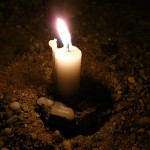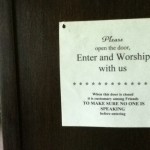Part I: A Very Differen Book From Genesis
Part II: God Becoming God
Part III: Thou Shalt Not Suffer A Witch To Live
Part IV: A Graven Image Is Worth A Thousand Words
When I began blogging about Genesis last summer, my plan was to plow through the whole Hebrew Bible, keeping up a lively commentary the whole time. But I’m a slow reader, and every door I open leads onto four or five more corridors that need to be explored. So, my apologies to readers who’ve been waiting with baited breath, but further commentaries on my biblical odyssey will be a bit sporadic.
Tonight I’m just back from a weekend workshop on the Hebrew Bible with Quaker author and curmudgeon Dick Kelly. It was interesting, and added a little breadth to what has been a fairly laser-focused study of the Bible so far.
Exodus is giving me fewer surprises than Genesis did. Genesis was such a mix of the very familiar and the utterly odd that I had to keep stopping to say, Holy cow! Did you see that? Not so with Exodus. One reason is that Cecil B. DeMille’s adaptation of the book was really surprisingly faithful. (“Of course it was,” said one Jewish friend of mine. “He knew who his audience was.”) Though the scene where the people are gathering around the foot of Mount Sinai and the priests are setting up a perimeter in preparation for the big appearance reminds me of another filmmaker, Steven Spielberg. I wasn’t familiar enough with scripture to pick up on the biblical influence when I first saw Close Encounters of the Third Kind, but reading the book now and looking back at the movie, the archetypal imagery is unmistakable.
One of the few actual surprises for me in Exodus is how verbose God is in that scene on the mountain. We all know there were ten commandments on those tablets, but seriously, between “I am the LORD your God…” and “…he gave to Moses, when he had made an end of speaking with him upon Mount Sinai, the two tables of the testimony, tables of stone, written with the finger of God,” I count at least seventy nine separate commandments spanning almost a dozen chapters.
The eleventh commandment: “An altar of earth you shall make for me and sacrifice on it your burnt offerings and your peace offerings, your sheep and your oxen; in every place where I cause my name to be remembered I will come to you and bless you. And if you make me an altar of stone, you shall not build it of hewn stones; for if you wield your tool upon it you profane it. And you shall not go up by steps to my altar, that your nakedness be not exposed on it.” (!)
And the twelfth: “When you buy a Hebrew slave, he shall serve six years, and in the seventh he shall go out free, for nothing. …”
The thirteenth: “When a man sells his daughter as a slave, she shall not go out as the male slaves do. …”
The twenty-first commandment is one specifically rescinded by Jesus: “If any harm follows, then you shall give life for life, eye for eye, tooth for tooth, hand for hand, foot for foot, burn for burn, wound for wound, stripe for stripe.”
It goes on and on and on. Here are commandments 33-36: “You shall not permit a sorceress to live. Whoever lies with a beast shall be put to death. Whoever sacrifices to any god, save to the LORD only, shall be utterly destroyed. You shall not wrong a stranger or oppress him, for you were strangers in the land of Egypt.”
Number 54 is the injunction, “You shall not boil a kid in its mother’s milk.”
After the first sixty or so, Moses takes a break. He “came and told the people all the words of the LORD and all the ordinances; and all the people answered with one voice, and said, ‘All the words which the LORD has spoken we will do.’ And Moses wrote all the words of the LORD.” I get the image of Moses frantically trying to take dictation on—what? Papyrus?—until finally God takes pity on him and offers to give him hardcopy. “Come up to me on the mountain, and wait there; and I will give you the tables of stone, with the law and the commandment, which I have written for their instruction.”
And this is where we get the Close Encounters imagery. “The glory of the LORD settled on Mount Sinai, and the cloud covered it six days; and on the seventh day he called to Moses out of the midst of the cloud. Now the appearance of the glory of the LORD was like a devouring fire on the top of the mountain in the sight of the people of Israel. And Moses entered the cloud, and went up on the mountain. And Moses was on the mountain forty days and forty nights.”
Now the instructions get much more detailed. We get plans for the Ark of the Covenant, blueprints for a tabernacle tent with patterns for curtains and designs for candlesticks, carrying handles for a portable altar, and robes and headdresses and jewelry for the priests. The robes have to have bells sewn onto them so that “its sound shall be heard when he goes into the holy place before the LORD, and when he comes out, lest he die.” There are recipes for incense and instructions for butchering bulls and rams for an ordination ceremony. God concludes by referring Moses to a few craftsmen He trusts to be skillful enough to carry out the instructions, and only then does He hand over the tablets “written with the finger of God.”
So what was written on those tablets? The original Ten Commandments didn’t come up in this last set of instructions. And, when you think about it, “Thou shalt not kill” is something you could probably remember without having to write it down, but “for the breadth of the court on the west side there shall be hangings for fifty cubits, with ten pillars and ten bases. The breadth of the court on the front to the east shall be fifty cubits. The hangings for the one side of the gate shall be fifteen cubits, with three pillars and three bases. On the other side the hangings shall be fifteen cubits, with three pillars and three bases. For the gate of the court there shall be a screen twenty cubits long, of blue and purple and scarlet stuff and fine twined linen, embroidered with needlework; it shall have four pillars and with them four bases…” For that you might want to jot down a few notes. So it’s no surprise that the tablets “were written on both sides; on the one side and on the other were they written.”
But that’s not the really interesting part. The really interesting part is that it all changes later on.
After all these detailed instructions, and more, and then still more, and after the whole book of Leviticus with all its proscriptions and prohibitions and its picky, prickly, legalistic and closely worded rules and rules and rules—after a couple of centuries God is ready to chuck it all out the window. And I’m not talking about Jesus here; I’m talking about Amos. The God who begins in Genesis and Exodus by laying out a meticulous code of conduct to maintain the purity of his people, has found by the time of the prophets that it does not satisfy. In Amos, he loses all patience with empty ritual. “I hate, I despise your feasts,” he says, “and I take no delight in your solemn assemblies. Even though you offer me your burnt offerings and cereal offerings, I will not accept them, and the peace offerings of your fatted beasts I will not look upon. Take away from me the noise of your songs; to the melody of your harps I will not listen.” What does he want instead? “But let justice roll down like waters, and righteousness like an ever-flowing stream.” We also begin to see a truly universalist God in Amos. “Did I not bring up Israel from the land of Egypt,” he asks, but then he adds, “and the Philistines from Caphtor and the Syrians from Kir?”
The God who began as a jealous and insecure minor tribal deity is evolving into something really universal. He’s no longer a God who can be mistaken for a man in a chance meeting on the road.
Cool stuff.












